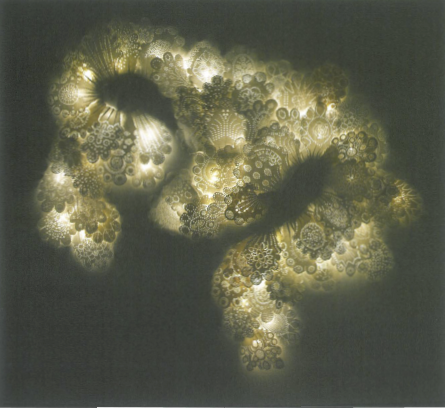
This exhibition aimed to gather work characterised by a certain refinement – and apparent resolution – of product (read: design qualities) but which prompted the deepening of perception one would expect from the visual arts. The exhibition's focus was also partly inspired by the easy cross-pollination that occurs between design and fine arts at the Tasmanian School of Art – a by-product of the cohabitation of the two disciplines within the same building, an uncommon situation in major Australian arts institutions.
Lucia Usmiani works with recycled materials (mainly plastics and sometimes cans) to create sculptural pieces which draw on the painting and installation mediums. Among the artist's preoccupations are ornamentation (particularly Baroque, Rococo and Islamic) and rekindling awareness of objects we have ceased to notice.
Usmiani employs repetitive patterning and labour-intensive processes, characteristic of the domestic crafts, in an effort to draw us back to otherwise overlooked materials. Often the artist's work has a sinuous quality and can also be characterised by a diffusion of light due to the opaque or transparent quality of the plastics that are her staple material.
Try Again is a lacy molecular drop of plastic bottle top inserts and monofilament that introduces the viewer to some of Deluxe's themes. This work reinvents manufacturing materials which are usually considered to have a single use into new aesthetic forms with a hint of functionality. Evident in Usmiani's work are the patterns and repetition of the applied arts with which she grew up. And the artist's hand crafting processes are a stark contrast to the machine fabricated origins of her building blocks. Two other pieces by Usmiani explore the concept of waste and the way pattern in domestic spaces can affect us.
Richard Skinner's undulating checkerboard, Wavescreen, is a thoughtfully lit piece that explores concealment and interaction and smudges our fixed notions of screen as interior barrier or visual divider. Instead it is an expansive and connecting form that sieves light and shadow between the spaces it interfaces. Its undulation is soothing and organic and the design becomes a source, rather than simply the neutral separator of visual effects.
With his remaking of post-consumer/post-industrial materials in the context of contemporary furniture design (a previous Skinner exhibition was based on packaging material from a confectionary company), Skinner asks (as Usmiani does) what exactly is waste?
Karen Lunn brings a printmaker's attention to layering and intensive process to her cross-media work. Her piece, Light Dress – one of the most satisfying in the exhibition – is both a delightful and resonant exploration of memory and the artist's Croatian heritage. Layers of hand-made, delicately pleated and punctured paper are backlit by a series of minute bulbs which have an ephemeral and energising effect; the soft edges glowing and suggestive of the illusive qualities of memory. Like much of Lunn's work, Light Dress was inspired by an old photograph of her grandmother wearing a full white skirt with lace-edged petticoats. It is a luminous work in more ways than one, inspiring one to linger between associations – ethnic lace, Indian henna design, Aboriginal dot motifs, or perhaps the organic glow of an oceanic life form – when not simply lost in the minutiae of the piece. Lunn touches on the meaning, both real and embellished, with which we bestow objects from the past. The ways in which we ask artefacts to provide proof of otherwise intangible cultural connections.
With these pieces, and those of Fred Fisher, Megan Keating, Ona Kaukenas, Fiona Lee and Adrian Read, there is a fascination with repetition and patterning, as well as intimate, intensive processes that draw one back to the material. With this, most of Deluxe's works playfully belie their slick surfaces; and the most successful coax the observer to unexpected places, although always with a careful and ironic hand.












